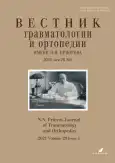Aspects of surgical treatment in a petient with Isaac’s syndrome
- Authors: Koryshkov N.A.1, Mikhailova L.K.2, Khodzhiev A.S.3, Litvinov I.I.1
-
Affiliations:
- Yaroslavl State Medical University
- N.N. Priorov National Medical Research Center of Traumatology and Orthopedics
- STAR MED CENTER Clinic
- Issue: Vol 28, No 1 (2021)
- Pages: 29-34
- Section: Articles
- URL: https://journals.rcsi.science/0869-8678/article/view/54470
- DOI: https://doi.org/10.17816/vto54470
- ID: 54470
Cite item
Full Text
Abstract
This article presents a clinical case demonstrating the correction treatment of the lower extremities in a patient with Issac’s syndrome, as well as the results of ankle surgery and successful post-surgery rehabilitation. The high efficiency of surgery as a treatment method was confirmed.
Full Text
##article.viewOnOriginalSite##About the authors
Nikolay A. Koryshkov
Yaroslavl State Medical University
Author for correspondence.
Email: nik-koryshkov@yandex.ru
ORCID iD: 0000-0003-4465-2660
SPIN-code: 9258-6260
PhD, associate professor
Russian Federation, 5 Revolutionnaya, Yaroslavl, 150000Lyudmila K. Mikhailova
N.N. Priorov National Medical Research Center of Traumatology and Orthopedics
Email: uchsovet1@cito-priorov.ru
SPIN-code: 8866-0410
PhD, professor, traumatologist-orthopedist
Russian Federation, MoscowArtur S. Khodzhiev
STAR MED CENTER Clinic
Email: hoji6600i@yahoo.com
SPIN-code: 9960-8290
Cand. Sci. (Med.), traumatologist-orthopedist
Uzbekistan, TashkentIgor I. Litvinov
Yaroslavl State Medical University
Email: litorthorus@mail.ru
ORCID iD: 0000-0003-1135-4376
SPIN-code: 2730-1365
PhD, associate professor
Russian Federation, 5 Revolutionnaya, Yaroslavl, 150000References
- Ponomarev VV. Redkie nevrologicheskie sindromy i bolezni: nablyudeniya iz praktiki. Saint Petersburg: Foliant; 2005. P. 41–48. (In Russ.)
- Yakhno NN, editor. Bolezni nervnoi sistemy. Vol. 1. Moscow: Meditsina; 2005. P. 637–638. (In Russ.)
- Dhand UK. Isaacs’s syndrome: clinical and electrophysiological response to gabapentin. Muscle Nerve. 2006;34(5):646–650. doi: 10.1002/mus.20591
- Luk’yanov MV, Khvorostina AV, Isaeva NA. Diagnosis and treatment of Isaac’s syndrome. Nevrologicheskii zhurnal. 2003;8(6):21–26. (In Russ.)
- Ponomarev VV. Autoimmunnye zabolevaniya v nevrologii. Minsk: Belaruskaya navuka; 2010. P. 104–109. (In Russ.)
- Meinck HM. Stiff-Man syndrome. In: Lang F, editor. Encyclopedia of molecular mechanisms of disease. Berlin: Springer; 2009. P. 540–542.
- Dumitru D, editor. Electrodiagnostic medicine. St. Louis: Mosby; 1995. P. 501–503.
- Falace A, Striano P, Manganelli F, et al. Inherited neuromyotonia: a clinical and genetic study of a family. Neuromuscul Disord. 2007;17(1):23–27. doi: 10.1016/j.nmd.2006.09.014
- Maddison P. Neuromyotonia. Clin Neurophysiol. 2006;117(10):2118–2127. doi: 10.1016/j.clinph.2006.03.008
- Panagariya A, Kumar H, Mathew V, Sharma B. Neuromyotonia: clinical profile of twenty cases from northwest India. Neurol India. 2006;54(4):382–386. doi: 10.4103/0028-3886.28110
Supplementary files













